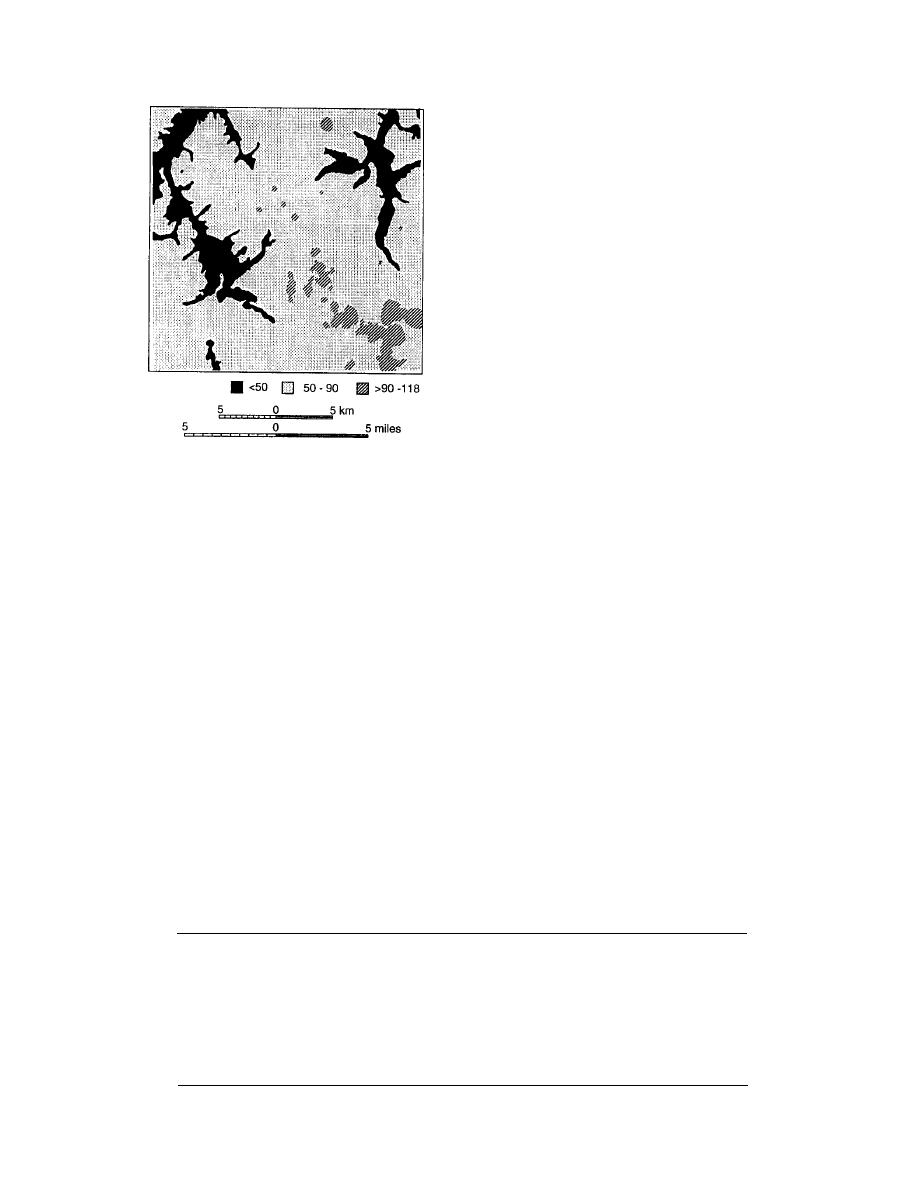
central Germany are 2030 cm, with midwinter
average snow densities of 0.250.30 g/cm3. A
good set of worst-case numbers for central Germa-
ny are a minimum snow density of 0.04 g/cm3 and
a maximum snow depth of 60 cm. [The minimum
snow density value is slightly lower than the low-
est value obtained in the field mobility tests at
CRREL, reported by Richmond (1993).]
One of the relatively few locations where snow-
fall and snow depth data are readily available is
Fulda (U.S. Navy, U.S. Air Force, Dept. of Com-
merce 1992). The average January temperature at
Fulda was approximately 0.3C over the period of
record (19601990). This implies an estimated av-
erage maximum snow depth of 15.6 cm. The aver-
age of the recorded yearly snow depth maxima
over the same period of record was 12.3 cm, which
means that the algorithm is somewhat inaccurate
in this case, but still close enough to be useful for
initial mobility analysis purposes, in the absence
Figure 1. Average annual snowfall (cm), Hunfeld
of further information. Two important parameters
Quadrangle area. (After Causey and West 1990.)
have been left out of this simple algorithm: eleva-
The most obvious limitation of Bates and
tion and wind speed. Fulda's elevation (301 m) is
Bilello's approach is that Germany is not the U.S.
relatively high for central Germany (though obvi-
However, the German snowfall data do appear to
ously much lower than the more alpine locations
be similar to the U.S. data, and it seems safe to
to the south), as is its average wind speed (5 knots,
assume (in the absence of better data) that snow
or 2.6 m/s).
values are comparable in the two regions.
A long-term frequency distribution for snow
An equally important, though slightly less
depth at Fulda for 19601990 is shown in Table 6.
obvious, limitation is that the climatic data in the
Even during the three snowiest months of the win-
study were collected at open, urban locations. The
ter (December through February) there is usually
no measurable snow on the ground at Fulda: for
microclimatic conditions on the battlefield would
example, even in the snowiest month, January,
not, of course, necessarily be similar to those
found at the places where the recordings are being
there was no measurable snow on the ground 59%
made. Luckily, there are also a number of rural ar-
of the time. The median snow cover when there is
eas in the northeastern U.S. where field data have
a measurable snow cover is approximately 23 in.
been collected. As at Fort Greely, this study has
(58 cm), but the snow depth can get much greater
the additional limitation of not addressing the is-
on occasion. The deepest snow recorded between
sue of drifting, which is crucial to vehicle mobility.
1960 and 1990 at Fulda was 46 cm, in both January
Average midwinter average snow depths for
and February 1963.
Table 6. Frequency distribution for daily snow depth at Fulda AAF, Germany (5033′N,
00939′E, 301 m elev). The data are derived from the Internation Station Meteorological Cli-
mate Summary (U.S. Navy, U.S. Air Force, Dept. of Commerce 1992).
Amount
(cm)
Jan
Feb
Mar
Apr
May Jun
Jul
Aug Sep
Oct
Nov
Dec
Total
None
44.2
53.2
81.6
98.3
100
100
100 100
100
99.7
84.9
65.3
85.0
Trace
15.1
15.7
11.4
1.6
0.3
8.1
11.5
5.5
03
9.0
10.0
2.3
3.5
8.1
2.8
35
7.3
7.6
1.7
0.1
1.4
5.1
2.0
610
7.2
2.9
1.1
1.5
4.1
1.5
1015
10.2
6.2
1.1
0.6
4.9
2.0
1630
6.3
0.8
0.9
0.9
0.8
3160
0.7
3.6
0.4
Meas. amt.
40.7
31.1
7.0
0.1
7.0
23.2
9.5
No. of obs.
764
713
754
688
687
685
685 700
666 701
714
738
8495
4



 Previous Page
Previous Page
